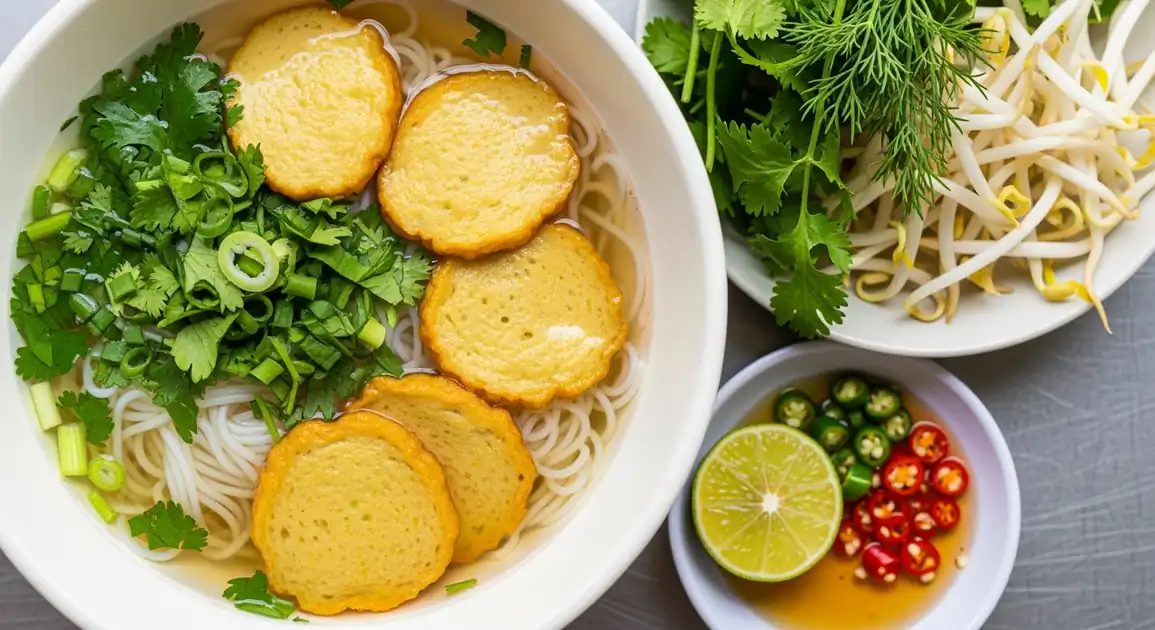Bun Cha Ca (Fish Cake Noodle Soup)
Bún Chả Cá

Description
Bun Cha Ca is widely available throughout Vietnam, though most authentic versions are found in Central Vietnam, particularly Da Nang. While regional variations exist across the country, the dish maintains its essential character of fish cakes served with rice noodles in a light, savory broth. Northern versions (particularly in Hanoi) tend to use different herbs and seasonings, while southern adaptations might incorporate more tropical ingredients.
Dietary Information
Serving information
Serving style
Typically served in a deep bowl with rice noodles and fish cakes in broth, accompanied by a separate plate of fresh herbs, bean sprouts, lime wedges, and chilies. Additional condiments like fish sauce and chili sauce are usually available on the table.
Quick facts
Most vendors operate from 6 AM - 8 PM, with some market stalls closing earlier (around 2 PM) and popular street vendors sometimes selling out before their official closing time.
Safety Tips
What to Look For
-
Constantly simmering broth
Ensure the broth is kept at a rolling simmer or boil, which kills most harmful bacteria and indicates freshness.
-
Clean, organized herb trays
Fresh herbs should look vibrant, be stored covered when not in use, and kept separate from raw ingredients.
-
Fish cakes with bright, consistent color
Quality fish cakes have a uniform golden-yellow color from turmeric, with visible herbs and a bouncy texture when pressed.
-
High customer turnover
Popular stalls with a steady stream of customers ensure ingredients don't sit around long and indicates local approval of quality.
What to avoid
-
Pre-portioned noodles sitting at room temperature
Noodles should be freshly portioned or kept refrigerated until used, not sitting in pre-prepared bowls.
-
Cloudy, excessively oily broth
Quality broth should be relatively clear and clean-tasting. Excessive cloudiness may indicate poor preparation or old broth being reused.
-
Vendors handling money and food without washing hands
Look for vendors who have separate people handling money and food, or who wash hands/use gloves between these tasks.
-
Fish cakes that look pale, grayish or have an overly strong fishy smell
These indicate either poor-quality fish, old fish cakes, or improper preparation techniques.
Price information
Price range
Budget tips
- Street vendors typically offer the most affordable bowls (25,000-35,000 VND).
- Prices increase in tourist areas; walking a few blocks away can save 10,000-15,000 VND per bowl.
- Lunch prices are often lower than dinner at the same establishments.
- Adding extra fish cakes ('thêm chả') costs around 10,000-15,000 VND.
Value indicators
- Generous portions of handmade fish cakes (not commercial or factory-made).
- Abundant fresh herbs provided without extra charge.
- Clear, flavorful broth that isn't watered down.
- Complimentary tea often indicates a quality-focused establishment.
Where to Find This Dish
Market Areas
Food sections of local markets often feature multiple Bun Cha Ca vendors competing for business.
Ben Thanh Market, Dong Ba Market, Han Market
Morning, Lunch
Street Food Alleys
Narrow alleys dedicated to street food frequently include at least one Bun Cha Ca specialist.
Food streets, Local neighborhoods
Lunch, Evening
Coastal Areas
In coastal cities, areas near fishing ports often have the freshest fish cakes.
Fishing harbors, Seafood markets
Morning, Lunch
Vendor Tips
- The most authentic vendors often have limited menu options, focusing on just Bun Cha Ca and perhaps a few related dishes.
- Look for places making their own fish cakes on-site rather than using commercial products.
- In tourist areas, stalls with primarily local clientele usually offer better quality and value.
How to Order
Regional Variations
-
Bun Cha Ca with Pineapple and Tomato
(Bún Chả Cá Thơm Cà Chua)
The traditional Da Nang variation that includes chunks of fresh pineapple and tomato in the broth, adding subtle sweetness and acidity that balances the fish flavor.
-
Bun Cha Ca with Rice Paddy Herb
(Bún Chả Cá Với Rau Om)
Features rice paddy herb (ngò om/rau om), giving a unique citrusy, cumin-like flavor that pairs exceptionally well with fish.
-
Bun Cha Ca with Vermicelli
(Bún Chả Cá Miến)
Uses glass noodles (miến) instead of rice noodles, creating a slightly chewier texture that some prefer with the fish cakes.
-
Dry Bun Cha Ca
(Bún Chả Cá Khô)
A variation where the noodles and fish cakes are served separately from the broth, allowing diners to dip or pour as preferred.
Cultural context
History
Originating in Central Vietnam, particularly Da Nang, Bun Cha Ca evolved from the region's abundant access to fresh seafood and the influence of ancient Cham cuisine. The dish represents the local preference for fish over meat, with the distinctive addition of turmeric (a spice historically important in Central Vietnamese cooking) giving the fish cakes their signature golden color. While variations exist throughout Vietnam, Da Nang's version is considered the most authentic, featuring specific preparation techniques that create the characteristic bouncy texture of the fish cakes.
Local significance
Bun Cha Ca represents the coastal heritage of Vietnam, particularly Central Vietnam's emphasis on seafood and lighter, cleaner flavors compared to the meat-heavy dishes of the north or the sweeter profiles of the south.
Eating customs
- Customizing with herbs and condiments is expected - being hesitant with additions might be seen as not fully appreciating the dish.
- Slurping noodles and broth is completely acceptable and even appreciated as a sign of enjoyment.
- It's common to order additional fish cakes if you particularly enjoy them.